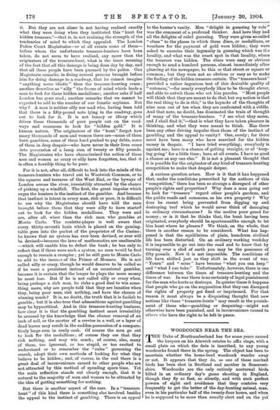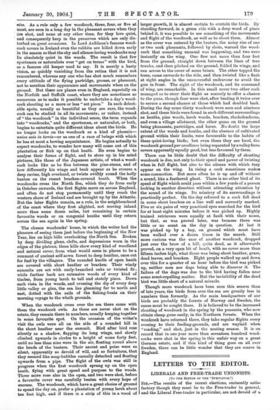WOODCOCKS NEAR THE SEA.
THE Duke of Northumberland has for some years caused
the keepers on his Alnwick estates to affix rings, with a small plate on which the date is inscribed, to any young woodcocks found there in the spring. The object has been to ascertain whether the home-bred woodcock wander away or not. It appears that they do, as one of these marked birds has been shot in Scotland and another in Somerset. shire. Woodcocks are the only entirely nocturnal birds killed in an ordinary day's game shooting in England, though they fly so fast, so silently, and with such perfect powers of sight and avoidance that they contrive very frequently to get the better of the day-hunting animal, man, even in his particular half of the twenty-four hours, and when he is supposed to be more than usually alert and on the qui
vire. As a rule only a few woodcock, three, four, or five at most, are seen in a long day in the pheasant covers when they are shot, and none at any other time, for they love quiet, and consequently keep in the preserves which are only dis- turbed on great occasions. In Lord Ardilaun's famous wood-
cock covers in Ireland even the rabbits are killed down early in the season so that the shy and silence-loving woodcocks may lie absolutely quiet in the woods. The result is that few sportsmen or naturalists ever "get on terms" with the bird, as a famous old keeper used to say. It is merely a hasty vision, so quickly vanishing from the retina that it is not remembered, whereas any one who has shot much remembers every attitude of the flying partridge, grouse, or pheasant, not to mention their appearance and movements when on the ground. But there are places even in England, especially on the Norfolk and Suffolk coast, where they are sometimes so numerous as to make it possible to undertake a day's wood- cock shooting as a more or less "set piece." In such delect- able spots, usually as beautiful as they are rare, the wood- cock can be studied in all its movements ; or rather, instead of "the woodcock" in the individual sense, the term expands into "woodcocks," and the sportsman, or naturalist, or both, begins to entertain quite different ideas about the birds. He no longer looks on the woodcock as a kind of phoenix- unica mule in terris—or as one of a race of beings with which he has at most a bowing acquaintance. He begins actually to expect woodcocks, to wonder how many will come out of this plantation or flick up on that heath. He even begins to analyse their forms of flight, and to store up in his mind pictures, like those of the Japanese artists, of what a wood- cock looks like as he flies between the pine-stems, and of how differently his wings and beak appear as he crosses a deep ravine, high overhead, or twists swiftly round the holly bushes on the russet bracken-covered heath. When the woodcocks cross the North Sea, which they do from early in October onwards, the first flights move on across England, and often do not stop permanently until they reach the western shore of Ireland and are brought up by the Atlantic. But the later flights remain, as a rule, in the neighbourhood of the coast where they first alighted, not moving inland more than some dozen miles, but remaining in certain favourite woods or on congenial heaths until they return across the sea again in the spring.
The chosen woodcocks' home, in which the writer had the pleasure of seeing them just before the beginning of the New Year, lies on high hills overlooking the North Sea. Broken by deep dividing glens, clefts, and depressions worn in the edges of the plateau, these bills show every kind of woodland and natural cover, from what would seem in places to be a remnant of ancient self-sown forest to deep heather, once cut for fuel by the villagers. The rounded knolls of open heath are covered with short heather or bracken. Their windy summits are set with curly-branched oaks or twisted fir; while further back are extensive woods of every kind of timber, from young larch to tall and stately pines. Down each vista in the woods, and crossing the dip of every deep little valley or glen, the sea lies gleaming far to north and east, dotted with the sails of the fishing-boats on their morning voyage to the whelk grounds.
When the woodcock cross over the sea there come with them the woodcock owls. As these are never shot on the estate, they remain there in numbers, usually keeping together in some favourite spot. On the occasion of the writer's visit the owls were all on the side of a rounded hill in the short heather near the summit. Bird after bird rose silently as a shadow, flapping its long wings, and slowly climbed upwards in circles to a height of some forty feet, until no less than nine were in the air, floating round above the heads of the beaters. Their ascent and poise were so silent, apparently so devoid of will, and so fortuitous, that they seemed like soap-bubbles casually detached and floating upwards from a pipe. The flight of the owls was still in progress when the first woodcock sprang up on the open heath, flying with great speed and purpose to the woods. Three more rose also in the open, and two were shot, before a favourite cover was carefully beaten with every hope of success. The woodcock, which have a great choice of ground to spend the day on, prefer a plantation of young larch about ten feet high, and if there is a strip of this in a wood of
larger growth, it is almost certain to contain the birds. By standing forward, in a green ride with a deep wood of pines behind it, it was possible to see something of the movements and flight of the woodcock, as well as to shoot them. Almost as the cover was entered by the beaters, the noisy rise of one or two cock pheasants, followed by shots, warned the wood- cock that something unusual was happening, and two were instantly on the wing. One flew not more than four feet from the ground, straight down between the lines of tree trunks, and then pitched on the ground, folded its wings, and ran across to the cover of some briars. The other topped the trees, came onwards to the ride, and then twisted like a flash at right angles in the unsuccessful endeavour to avoid the gun in front. The sight of the woodcock, and its command of wing, are remarkable. In this small cover two other cock managed so to steer their flight as scarcely to offer a chance to the guns, though four were shot, after beating it twice over to secure a second chance at those which had doubled back. During the day some thirty woodcock were seen and nineteen shot, and these birds were found in such different surroundings as heaths, pine woods, larch woods, bracken, rhododendrons, and even a village allotment, the other game on the ground being pheasants, partridges, and hares. No doubt the large extent of the woods and heaths, and the absence of cultivated ground within their limits, were favourable to the habits of these quiet-loving birds; but even there they are local, the woodcock ground par excellence being separated by avalley from covers apparently equally good, but less favoured by them.
There can be little doubt that the difficulty of shooting woodcock is due, not only to their speed and power of twisting when in full flight, but also to the silence with which they appear on the wing. In rising a cock sometimes makes some commotion. But more often he is up and off without a sound, like a feathered ghost. There is no other bird of its speed of flight which could pass within a few yards of a person looking in another direction without attracting attention by the sound of its wings. Its mimicry of its surroundings is practically perfect. On the day referred to a cock fell dead in some short bracken on a line well and correctly marked. Five or six pairs of very practised eyes searched for the bird for at least eight minutes before it was picked up. Highly trained retrievers were equally at fault with their noses, but that, as was proved later, was because there was little or no scent on the day in question. At last it was picked up by a boy, on ground which must have been walked over a dozen times in the search. Still more curious was the case of another woodcock, dropped just over the brow of a hill, quite dead, as it afterwards proved, on a very open bit of heath, with no cover more than fifteen inches high, what there was being short heather, grass, dead leaves, and bracken. Eight people walked up and down over this for a quarter of an hour before the bird was picked up, neither men nor dogs being able to discover it. The failure of the dogs was due to the bird having fallen near some scent-repelling matter. But the invisibility of the dead bird was little short of a natural miracle.
Though more woodcock have been seen this season than of late years, the birds from over the sea are greatly less in numbers than formerly. As the main headquarters of our birds are probably the forests of Norway and Sweden, the cause must be sought there. It is believed to be the increased shooting of woodcock in the spring by the peasants, who now obtain cheap guns easily, in the Northern forests. When the woodcock have returned there, they take regular flights every evening to their feeding-grounds, and are waylaid when "roading," and shot, just in the nesting season. It is on record that in one year more than seventeen hundred wood- cocks were shot in the spring in this unfair way on a great German estate, and if this kind of thing goes on all over Sweden, there can be little wonder that they are scarce in England.























































 Previous page
Previous page